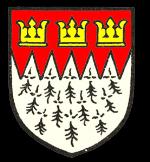Limbury Manor
Limbury was a sub-manor, held of the Manor of Luton. Ther first reference to it is as a house and a carucate of land held by Richard de Lymbury in 1275. In 1368 Philip de Lymbury died in Constantinople, leaving the manor to his son Philip. The manor then included a house, 102 acres and a watermill which was greatly in disrepair as well as 53 shillings 4 pence in quitrents. This Philip was recorded as an enemy of the Abbey of Saint Albans, ordering one of its monks to be pilloried on market day.
Philip must have died before 1388 because in that year his mother Joan, who had married John de Clayton, died and left Limbury Manor to her daughter Elizabeth, wife of Thomas Tryvet. Elizabeth must have died almost immediately because in 1389 Thomas himself held the manor, now worth only twenty shillings per annum. Tryvet had two daughters, aged seven and five in 1389 but after this date there is no reference to the manor in the surviving historical record.
There was, confusingly, a second Limbury Manor, also held as a sub-manor of the Manor of Luton. It is first mentioned in the surviving historical record in 1386 when, like Biscot Manor, it was in the hands of Baldwin de Bereford, who settled it on the heirs of his three aunts in 1401. Baldwin's widow Elizabeth held the manor until her death in 1419 when it passed to Ralph Bush, who conveyed it almost immediately to William Acworth.

Acworth coat of arms
In 1500 John Acworth held the Manor of Biscot as tenant. He was succeeded by his son George and at his death in 1531 his son, another George succeeded. George junior sold the manor in 1549 to John Dormer of London, who transferred it to another London merchant, William Harper, the next year. In 1555 Harper sold the tenancy of the manor to John Alley. No further mention is made of the manor in the subsequent surviving historical record, suggesting it was absorbed into the more important manor of Biscot.